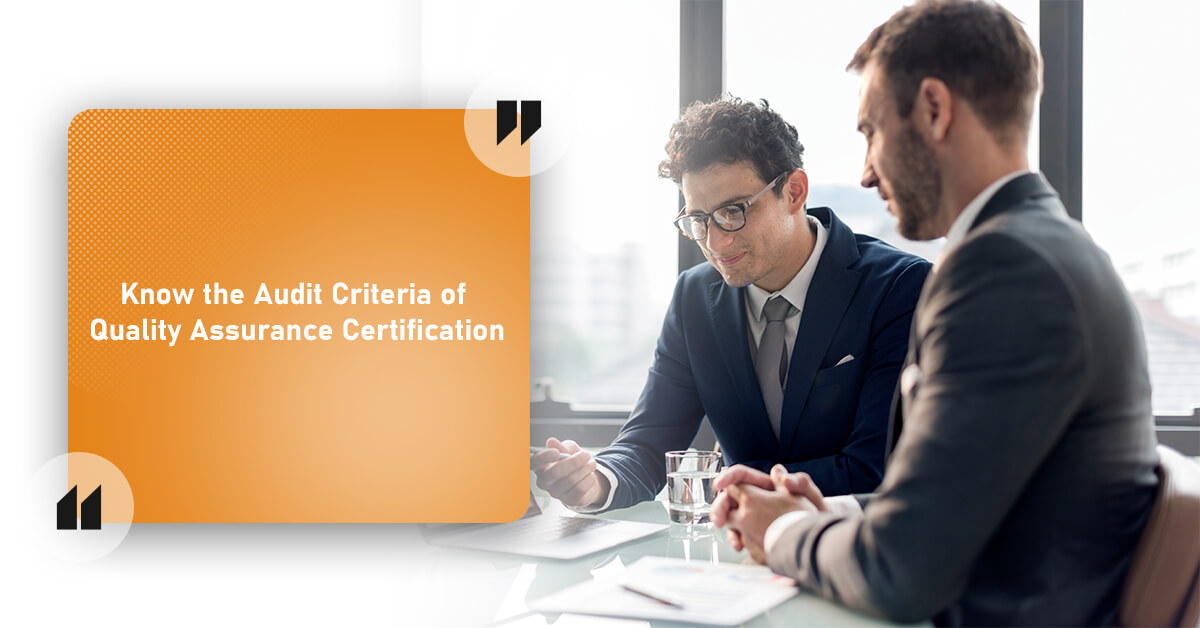Know the Audit Criteria of Quality Assurance Certification

If you have created a quality management system (QMS) for your business considering the requirements of the top-quality assurance certification, ISO 9001, the next step is to get prepared for the certification audit. Now, what is the certification audit? What should you do to fulfill the audit criteria of the quality assurance certification? Well, this blog explains it all.
The certification audit is a process when experienced auditors from a third-party certification body will review your QMS, processes, documented records, and employees’ roles to ensure that everything works according to the ISO 9001 requirements. Passing the audit is an obligatory step for you to obtain the certification. If the auditors find any noncompliance issue anywhere, they will provide suggestions/corrective actions and you need to execute in order to finally be eligible for the ISO 9001 certification.
Since the process of auditing is a serious step for successful certification, we have pointed out the criteria here below for passing your certification audit smoothly at one go. Take a look.
Criteria for Passing Audit of the ISO 9001 Quality Assurance Certification
Address Each Clause of the Standard
The external auditors are first going to check whether all clauses of ISO 9001 are met by your organization. They do that by thoroughly reviewing your documentation. They compare your documented processes with requirements under each clause of the standard. It helps them to discover the processes which do not align with standard.
They can also ask questions like how the processes are executed or who executes them to check whether your answers match with what is documented. During the documentation review, auditors can also easily identify the processes which are not documented and point them out.
Ensure Consistency in Your Processes
An important criterion for ensuring your quality assurance certification is consistency in the processes of your organization. Every process, starting from purchasing of supplies/raw materials, manufacturing, logistics operations to delivery and customer services, have an impact on the quality of your products or services. The auditors evaluate end to end processes in your organization to ensure that final outcomes are always consistent.
For instance, they can check how two different members get a purchase order and use the materials in a given task. If there are major differences in their approach, it could possibly result in two varied outcomes i.e., differences in the quality level of products. So before auditors find out any inconsistency in your processes, you need to avoid that with proper documentation and employee training. When instructions on performing every task are laid out in a written QMS, the employees can follow them and eliminate any ambiguities in their approach.
Conduct Management Reviews
Apart from personally reviewing your processes and documentation, the auditors are also going to enquire whether your organization has done its individual part in making your QMS compliant with the ISO 9001 requirements. So, your senior management should be conducting reviews, also called as internal audits to be affirmative from your end. You should also be presenting the findings of your internal audits with precise reports. They would disclose what nonconformities or issues were identified, addressed, and then followed up.
Implementation of the Corrective Actions
The auditors will be checking whether any recurring as well as one-time problems in your QMS are resolved with corrective actions as soon they are identified. They are going to cross-check and interview your members to know how quick you were in implementing the corrective actions every time for rectifying the flaws in your QMS.
If the auditors ever uncover after reviewing your internal audit reports that a problem in your QMS has emerged often but you have not got it resolved, your certification can be at stake.
Use a Risk-Based Approach
The ISO 9001 standard mandates organizations to focus on a risk-based approach to prevent errors in the processes and flaws in the end products or services. The auditors are going to confirm that. They will enquire your management team about how you conduct risk assessment every day into all the areas in your organization. They will also interview the employees who are responsible for the quality assurance processes to know the methods and actions being taken to address the risks.
Preparation for Continual Improvement
The last key criterion for becoming eligible for ISO certification and passing the audit is a plan for continual improvement of the QMS. The auditors will expect you to present a feasible plan for performing periodic assessments of your QMS and modifying it for better effectiveness. They will enquire what improvements you are looking for, how you are tracking the performance/effectiveness of the QMS, and how fast you can deploy the changes.
Bottom Line
Passing the external certification audit is the last but the key step needed for successful ISO 9001 certification. It ensures your compliance with the requirements of the standard and gets you certified in one go. You should hence make sure to put your best efforts into it!
These are the intrinsic audit criteria of quality assurance certification and you should not fail at any one of them. Provide your employees with adequate training and get a proactive management team to look into each of these prior to your certification audit. Most importantly, you should get your people, processes, documentation, and QMS procedures organized before facing the auditors. Your managers should initially inspect every area and only after confirming that everything is in place, you should schedule your certification audit and contact the auditors.
Are you worried about your upcoming certification audit? Our experts can help you pass that effortlessly! At Compliancehelp Consulting LLC, we are a team of professional ISO consultants and internal auditors who can get your organization ready for the certification audit after assessing your processes and checking on these vital criteria.
Liked the blog? Keep following this section for more information on quality assurance certification and compliance.


